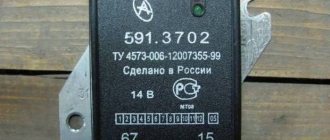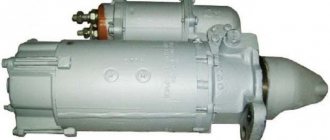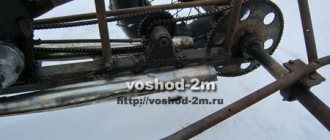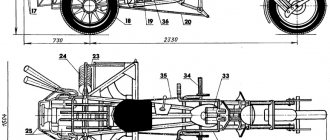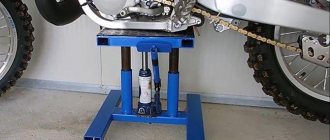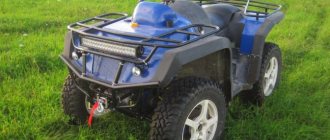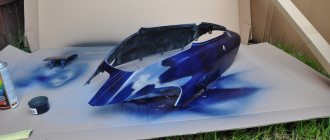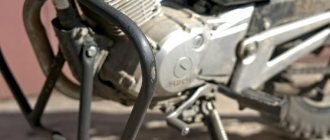A towbar is a simple but mandatory device in a car, designed to tow it if it is impossible to continue driving “under its own power.” It can also be used in passenger cars to transport small trailers.
If you choose the right tow bar for your car, it can not only increase the car’s ability to transport heavy loads, but also help pull your vehicle out of the mud or a deep ravine, deliver it to a repair shop, or provide the same assistance to your fellow car enthusiast.
The purpose of a towbar is to securely connect your car to a trailer or another vehicle, depending on the circumstances. But at the same time, the car must maintain sufficient maneuverability. That is why the tow bar has a rounded shape - it allows the attached trolley to turn.
There are several types of towbars:
- different in width (European and American standard);
- stationary and removable;
- flanged;
- small, medium, large (divided according to load parameters, designed for trailers of different carrying capacity);
- towbars with conditionally detachable fastening.
European and American towbars differ in the size of the ball. For products from Europe it does not exceed 50 millimeters. These devices are the most compatible with Russian-made cars.
As for stationary and removable towing devices, there are also varieties among them. Since a towbar for a passenger car is far from obligatory (few people carry any cargo other than what fits in the trunk), it can be attached either permanently or temporarily. A permanently mounted tow hook is usually screwed or welded to elements of the frame or body of the car, and after that it can no longer be removed. But recently, many quick-release devices for towing trailers have appeared on sale, which are not inferior in reliability to stationary ones. What could a twenty-first century towbar be like? Take a look at this photo.
Towbars of different types
Installation nuances for 2WD and 4WD versions
A towbar is suitable for Duster, which is held on by four M10 screws (see photo). Each screw is threaded into a sleeve, which is installed from inside. The standard length of bushings is 53-55 mm, and the bushing should end with a washer.
One of the branded Duster-Logan towbars
The holes are already drilled in the body, and the distance between them is 240 mm. And the distance between the brackets is 890 mm. Perhaps, knowing these numbers, the reader will decide to make a tow bar for Renault Duster with his own hands.
Front-wheel drive towbar version
Almost all towbars suitable for the 4x4 version are compatible with a single-wheel drive Duster. Only installation does not proceed without modifications. The “bumper tongue” is cut off, but more often a rectangular cutout is made. A drawing of this cutout should come with the towbar kit. You can also make a homemade tow bar according to our drawings.
Drawing from the installation instructions
The bumper is usually removed to modify it. In general, the tow bar is installed without dismantling the standard devices. But this applies to the 2WD version.
On sale you can find a design compatible with the Duster 2WD bumper. Make sure that this design itself does not interfere with the spare tire. Often you have to choose what to sacrifice - a bumper or a spare tire.
Some imports
It will be difficult to find an option that does not interfere with either one or the other. But such options also exist.
Please note that the towbars on the Renault Duster 4x4 are designed more simply. There is no need to make “outlines”, as shown in the photo. Everything that is suitable for the 2WD version is also compatible with the 4WD version. But why pay more?
Modification of a car with all-wheel drive
In general, installing a tow bar on a Renault Duster consists of two stages: we screw on the “cheeks” (brackets) and install the beam on them. So, when installing the beam you have to remove one part. It is not possible to return it back, but it is called a “protective screen”.
Muffler heat shield
According to owner reviews, you can operate a car without a protective screen for an indefinitely long time.
In the 4WD configuration there will be no need to file or remove anything except the muffler screen.
Installation nuances for 2WD and 4WD versions
A towbar is suitable for Duster, which is held on by four M10 screws (see photo). Each screw is threaded into a sleeve, which is installed from inside. The standard length of bushings is 53-55 mm, and the bushing should end with a washer.
One of the branded Duster-Logan towbars
We recommend: How long are windshield wipers on Renault Logan - we explain in detail
The holes are already drilled in the body, and the distance between them is 240 mm. And the distance between the brackets is 890 mm. Perhaps, knowing these numbers, the reader will decide to make a tow bar for Renault Duster with his own hands.
Front-wheel drive towbar version
Almost all towbars suitable for the 4x4 version are compatible with a single-wheel drive Duster. Only installation does not proceed without modifications. The “bumper tongue” is cut off, but more often a rectangular cutout is made. A drawing of this cutout should come with the towbar kit. You can also make a homemade tow bar according to our drawings.
Drawing from the installation instructions
The bumper is usually removed to modify it. In general, the tow bar is installed without dismantling the standard devices. But this applies to the 2WD version.
>
On sale you can find a design compatible with the Duster 2WD bumper. Make sure that this design itself does not interfere with the spare tire. Often you have to choose what to sacrifice - a bumper or a spare tire.
Some imports
It will be difficult to find an option that does not interfere with either one or the other. But such options also exist.
Please note that the towbars on the Renault Duster 4x4 are designed more simply. There is no need to make “outlines”, as shown in the photo. Everything that is suitable for the 2WD version is also compatible with the 4WD version. But why pay more?
Modification of a car with all-wheel drive
In general, installing a tow bar on a Renault Duster consists of two stages: we screw on the “cheeks” (brackets) and install the beam on them. So, when installing the beam you have to remove one part. It is not possible to return it back, but it is called a “protective screen”.
Muffler heat shield
According to owner reviews, you can operate a car without a protective screen for an indefinitely long time.
In the 4WD configuration there will be no need to file or remove anything except the muffler screen.
Automaker help
It should be noted that the automaker took care of ease of installation, providing:
- Fastening points, providing them with protective plugs;
- A hermetically protected place in the luggage compartment for the output of the wiring harness;
- Self-installation of a towbar by car owners.
Note! The car is based on the Logan platform. For Renault Duster, the wheelbase was only increased by 40 mm. Therefore, installing a tow bar on a Renault Logan yourself is done in the same way.
Electrical connection
After installation on the Renault Duster, the towbar must go through the stage of connecting the electrical wiring kit to provide the vehicle with duplicate car signals at the rear, on the trailer. In this case, the towbar socket is used. Before carrying out work, disconnect the battery and proceed:
- Install the plug socket on a special platform of the traction device, securing the structure with screws.
- Open the wire plug located in the luggage compartment of the car, in the floor.
- At the next stage, pull the cable into the resulting hole carefully and slowly so as not to damage anything.
- After running the indicated wires into the trunk and securing the ends in the terminal block, find there the wires that need to be connected: fog lights (green), left turn (purple), right turn (green), brake lights (their wires can also be green), wire, side lights (blue), as well as leading to the body (black).
- Connect the specified wires to the outlet using copper wires with a diameter of at least one and a half square millimeters (from 1.5 to 2.5 sq. mm).
Please note that the electrical connection is carried out as follows (counting comes from the top connector of the socket and to the right in a circle):
- into the first connector - left turn signal,
- second and third - depending on the specific trailer layout,
- fourth - right turn signal,
- fifth - right side marker light,
- sixth - stop signal,
- the seventh (located in the center of the towbar socket) is the left marker.
The connection diagram may vary slightly depending on the individual characteristics of the distribution of electrical wiring in the towed vehicle.
Installation
On Renault Duster SUVs, installation of the towbar is carried out in several stages:
- The first thing you need to do before starting work is to check the equipment. The standard set includes a side strip, bolts, nuts, and electrical wiring for connecting the dimensions on the trailer.
- Remove the plug that is located inside the trunk and, being under the car, screw in the bolts that will secure the tow bar
- It is necessary to put the side plates on the installed bolts using washers and nuts; there is no need to tighten the nuts too much, since they will still need to be adjusted
- At the coupling device, use screws to fix the transverse beam so that it is completely covered by the bumper
- We make an electrical connection through special holes in the trunk, into a standard connector, and install a socket using screws. The process of connecting electrical wiring is quite responsible, so this part of the installation should be taken seriously; the included instructions with drawings can help with this.
Have you chosen? Now we put
First of all, carefully read the instructions, remove everything from the trunk and prepare your tools.
Tools
To work you will need:
- Bolts and nuts for fastenings
- Keys for 17 and 19
- Screwdrivers
- A trailer hitch with a full set of parts, that is, the tow bar itself.
Instructions
- Start by checking the hitch configuration. A standard towbar must have side bars, the necessary hardware and wiring to connect the warning lights to the trailer. Approximately as in the photo. Disassembled trailer hitch
- After checking that everything is in place, you can begin installation. Open the trunk, which has been previously cleared of excess items, and use a screwdriver to remove the plastic plugs located on the sides inside. Insert the towbar bracket mounting bolts into the vacated holes. It is precisely the fact that the car designers left the necessary holes that seriously simplifies the work. Those same plugs that need to be removed. We insert the bolts in place of the removed plugs.
- This must be done while under the bottom of the car.
- Now you need to put the side plates on the inserted bolts. The reliability of your entire towbar system will depend on them. These elements should be securely fixed with the nuts and washers included in the kit. Don't over-tighten them the first time, as adjustments may be necessary. This is what a properly installed towbar plate looks like
- When you are done with the plates, proceed to fixing the cross bar of the towbar. Special screws are used for this purpose. Make sure that the hitch bar is correctly positioned relative to the bumper, that is, it is completely covered by it and does not stick out. At this point, the installation of the main parts of the towbar is completed, only the most difficult part remains - the electrical wiring. The last main part of the towbar is installed
How to install and connect the electrical yourself
Make sure that all mechanical parts of the hitch are installed correctly and are secure. Only then can you install the platform with the towing hook and socket, and then finally screw in all the nuts holding the device.
With electrics, everything is not as scary as it seems at first glance. In general terms, it is enough to lead the wires from the socket into the trunk through the corresponding holes, fix their ends in the terminal block provided by the manufacturer and located in the luggage compartment, and then just connect them to the standard connector, as shown in the instructions.
Here is a diagram of the socket of one of the Russian towbars. Many others are made on exactly the same principle.
This is how the towbar socket contacts are located
The socket is placed on the towbar platform and attached to it with screws. Then you need to find another plug in the trunk in the floor itself, which closes the hole intended for the wires. We run the wiring harness there. It is necessary to strictly follow the instructions so that the on-board network of the machine does not fail. In general, you only need to perform three steps:
- Place the wires from the outlet into the trunk.
- Fix their ends in the terminal block
- Connect to the standard connector.
Video tip: “How to install a towbar socket on a Renault Duster with your own hands”
https://youtube.com/watch?v=-3ASG94rAnE
Since the towbars are supplied with all the necessary parts, there should be no problems with installation. After all the manipulations, do not forget to check how the light signaling on your trailer works. The safe operation of the towbar depends on your personal responsibility, and what is written is enough to understand how to install it correctly.
In my free time, I read a lot, play airsoft (a team military sports game) and amateur radio communications. Lots of professional connections. My strengths: communication skills, endurance, responsibility.
Installing the tow bar
Before installing the towbar, you need to consider several nuances:
- If you bought a ready-made kit, it will most likely contain self-locking nuts. This means that they can only be screwed once.
- M10 nuts must be finally tightened last, applying a force of about 45-50 N*m.
- If you purchased a ready-made 4WD version of the trailer hitch set, then in the process of tightening the fastening nuts, the tow bar itself will need to be pulled back.
- M10 screws must be lubricated with lithol or cyatim.
This is interesting: How to paint rims on a car yourself. Video lesson
Knowing these subtleties, you can begin the preparatory process. To do this, empty the luggage compartment of the SUV, remove the muffler and spare tire. After this, install the car over the inspection hole or use a jack. Prepare a screwdriver, 2 keys for 17 and 2 for 19. You will also need to disconnect the battery; to do this, just disconnect the negative terminal.
After this, it is necessary to divide the trailer hitch into its component parts and begin installation, which will require:
- Remove the factory plugs located under the trim on the right and left. To do this, carefully lift the trim and pry them off with a screwdriver.
- Insert the mounting bolts into the vacated holes. To protect them, use bushings that are installed inside the side members.
- Make sure the fasteners are installed correctly. Look under the car and make sure you can see the ends of the fasteners.
- Place the side brackets on the ends of the bolts, secure them with washers and tighten the nuts using a 19 mm wrench (give yourself the opportunity to adjust them, so do not over-tighten).
- Install the cross beam.
- Align the holes on one side of the beam and the side and attach a nut in this place. Repeat similar manipulations on the other side.
- Adjust the position of the beam and tighten all nuts.
- Install the tow hook.
After this, all that remains is to install the wiring in the towbar socket so that when connecting it to the trailer, the lights on the latter will work.
Towbar installation process
In Renault Duster, for the convenience of installing the tow bar by users themselves, the developers have provided:
- mounting holes that are closed with special plugs;
- a rubber plug for sealing the electrical connections in the trunk compartment.
To correctly and quickly assemble the entire towbar structure and connect its headlights to the car, carefully study the drawing and instructions.
Observe safety precautions by wearing rubber gloves and not touching bare wiring. The order of work is as follows:
- empty the car trunk, remove the spare tire, the muffler located on the rubber suspension;
- prepare a working tool - a screwdriver and 4 keys (a pair - 17, a pair - 19);
- install the Duster on an overpass or inspection hole. Use a jack if necessary;
- disconnect the battery (this can be done by disconnecting the minus terminal).
Disconnect the battery
After preparing the machine, divide the towbar into its component elements. Open the luggage compartment to remove the factory plugs. They are located under the car trim, 1 each on the left and right. Lifting the casing, open access to them, pry them off with a screwdriver and remove. Next, take the bolts from the towbar kit for the Duster and insert them into the holes located under the plug. To protect the bolts, install bushings inside the side members. You can see the end of the fastener by looking under the car.
Take the towbar brackets that attach to the side and place them on the ends of the bolts. After this, attach the washers to them and tighten the nuts, tightening them with a 19mm wrench. Start installing the main part - the beam, but first try it on to find out the correspondence between the trailer hitch plates.
Installing a towbar on a Renault Duster
To check that the holes of the part and the car match, insert the bolt from the wheel side and tighten it with a nut. Perform a similar action on the other side. After this, correct the position of the beam and tighten the nuts on it (before this, lubricate the threads on them).
The process of installing the towbar ends with the installation of the towing hook, which also needs to be secured using nuts and bolts of the “self-stop” type, which are included in the kit, using a 17mm wrench.
We select it for your car
There is a difference not only in size between American and European towing devices. They differ significantly in the type of fastening, as well as the center-to-center distance between fastening points. Naturally, this must be taken into account when choosing a device for your car. Their electrical connectors are also arranged differently, but if you have the necessary adapters, this will not create any obstacles to the installation and subsequent operation of the towbar on a car, no matter what model it is.
However, there are exceptions. In some cases, when installing American towbars with your own hands, due to the larger diameter of the ball, incompatibility with Russian trailers occurs. Roughly speaking, it is not always possible to connect such a hook to a domestic trailer, and sometimes you have to resolder the wiring.
We recommend: Replacing the Renault Logan reverse sensor
The American towbar consists of four parts, the main one of which is the bracket for attaching the tow hook to the rear bumper of the car. Usually it is located on a special rigid frame, which is attached to the car body. Only after taking these features into account can you begin to select a tow hitch for the Renault Duster.
Renault Duster is a mid-size car, endowed with the features of a passenger car and an SUV, that is, it belongs to the crossover class. The most preferable for this car are towbars with a type A ball, for example, Bosal or some products from Enganches Aragon. This type of ball has a conditionally removable design and is secured to the hook with two bolts.
You can also turn your choice towards the best-selling devices on the Russian market:
- Galia (Slovakia).
- Bosal (Belgium).
- Enganches Aragon (Spain).
- "Leader-Plus" (Russia).
- Thule (Sweden).
- Imiola Hakpol (Poland).
As we have already said, it is necessary to take into account the differences in the towing parameters of towbars from different manufacturers. Most Russian devices for trailers do not allow you to tow loads weighing more than 1200 kg, while some foreign analogues can pull 1800 without any problems. The main thing is to never take a towbar that has been used. It is already worn out and may break at the most inopportune moment.
Tips for use
In order to prolong the operation of the towbar and ensure the safety of other road users, it is necessary to carry out periodic maintenance of the towbar and its fastenings. The main thing is to inspect the bolted fastenings of the trailer hitch , as well as the reliability of the contacts of the trailer’s electrical equipment. Bolted connections require periodic tightening.
If you do not use the trailer for a long time, coat the hitch ball with a protective lubricant against corrosion and put a protective cap .
Important! Do not operate the machine with a trailer loaded with a weight of more than 1200 kg and driving at speeds exceeding 90 kilometers per hour.
A protective cap will protect the ball from rust
Source
Features of fastening the towbar
Let the towbar assembly consist of a beam with brackets. Then:
- Four holes for screws are prepared in the body;
- The brackets are secured to the body using an assembly of an M10 screw, a washer, a bushing, a second washer and a nut. None of the nuts have been tightened yet!
- The beam is attached to the brackets - usually M12 bolts are used;
- Tighten the nuts on the brackets (force 40-50 N*m). If we are talking about the 4WD version, the towbar beam must be pulled back.
Before step 2, the threads of all screws must be lubricated with lithol or cyatim.
All nuts included in the kit can be self-locking. They are twisted once! You will need an open-end wrench: “17” (screw or nut M10), “19” (M12).
Installation "step by step"
- In the luggage compartment we find plastic plugs on the side members and remove them. To do this, open the hatch on the right side. Then use a screwdriver to find the opposite holes in the bottom and remove the protective film.
Hatch and two plugs
- Next, the installation of the towbar on the Renault Duster is carried out according to the standard instructions: you need to install the screws, and the lubricant can be applied “from the street”.
Each screw is installed with a sleeve
- Install the brackets and install the beam. The fastening nuts are not immediately tightened.
M10 nuts are not fully tightened
- When all the “standard” elements are mounted, do the following: it is advisable to pull the beam back, while tightening the nuts. Lastly, tighten the nuts on the brackets (40-50 N*m). A torque wrench is rarely used, but not everyone knows how to dose force. We'll leave the choice to the owner.
More information about connecting a towbar to the car's electrical system: connecting the electrical system (wiring) of a towbar on a Renault Duster and a socket diagram.
Common mistakes
- They forgot about cyathim and lithol;
- The tightening sequence was violated (first M10, then M12 - incorrect);
- The beam was not pulled back;
- We did everything according to the instructions, but when tightening the M10 nuts, no force was applied to the beam. For the 4WD version, this option will not be acceptable.
Fastening the beam
Before installation, drive the car into the inspection hole, stop it with the parking brake and chocks under the wheels.
For reference: Installing a towbar on a Renault Logan with your own hands will be approximately the same as in the case of a Renault Duster. Today, one of the most popular among the owners of these cars is the kit of the domestic brand “Trailer”.
This is what the purchased device looks like
We start by installing the towbar beam, which is attached to the rear of your Duster’s body. It is installed on the side members in special holes, which are prudently closed with plugs.
Installation location - bottom view
Note! In this case, you don't even need to remove the rear bumper.
We will need to arm ourselves with a screwdriver, a pair of keys with heads 17 and 19, a towbar and accessories for connecting it. The side brackets of the towbar are connected to the side members with bolts and nuts. There is no need to tighten the fasteners ahead of time.
Use only the included elements for mounting
The basic instructions for carrying out the work will be approximately as follows:
- We take the towbar beam (TSU) and attach it to the side brackets. If necessary, the beam must be pulled back along the vehicle. Be sure to place the tow ball along the longitudinal axis of the vehicle.
Installing a beam under the rear bumper
- Before tightening fasteners, lubricate all holes and bolts with grease.
- We attach the coupling ball to the brackets.
- You can return the thermal protection, spare tire and muffler.
All that remains is to install the tow ball
Important selection features
Renault Duster comes in all-wheel drive 4×4 and mono-wheel drive (drive goes to the front wheels). Because of this, when buying a car from 2013, 2014, or maybe 2016 or our current 2022, not forgetting about 2015, be prepared to encounter some problems.
Most trailer hitches are compatible with all-wheel drive and single-wheel drive versions of the crossover. But installation will require some adjustments. For example, you often have to file a tongue on a bumper. There are versions of the trailer hitch that fit under the crossover bumper, but here you have to choose - leave the bumper intact or be able to carry a spare tire.
If this is an all-wheel drive version, then everything is somewhat simpler at first glance. You mount the brackets (in common parlance, cheeks), and then install them on the beam. But there is a nuance here. You will have to dismantle the protective screen, but you won’t be able to put it back. Although car owners claim that there is nothing wrong with this.
Manufacturers
After reading the thematic forum, hearing the opinions of people from different cities, such as Moscow, Ufa, St. Petersburg, and visiting Astana, where Duster is very popular, I made several conclusions regarding the towbar models themselves.
There are several leaders on the market:
- Bosal VFM;
- Trailer;
- Leader-Plus.
But before you buy a towbar and figure out how to install it on the car and connect the electrical system, I would like to discuss several countries that produce good towbars. All of them are available on the Russian market.
- Slovakia (Galia company). The price is quite high, up to 11-12 thousand rubles, but the bumper does not have to be removed during installation, it can withstand high loads and serves flawlessly;
- Belgium (Bosal). Excellent quality at a lower cost. But you can’t do without dismantling the bumper;
- Spain (Enganches Aragon). You will have to pay about 10 thousand rubles for them, but their horizontal loads of 2 tons will not leave you indifferent. Excellent quality;
- Poland (Imiola Hakpol). The most expensive models cost 9 thousand with a load capacity of 1.5 tons. The price corresponds to the quality;
- Russia (Leader-Plus). Designed for operation with loads up to 1.2 tons. They are cheap, so they are in great demand;
- Sweden (Thule). Excellent characteristics, but the minimum price is 11 thousand rubles per trailer hitch.
Frankly, I strongly advise you not to save money. Installing a low-quality tow bar can have dire consequences.
Knowing how much a particular towbar costs, how well it fits your Duster and wallet, you can choose a decent option.
Features of fastening the towbar
Let the towbar assembly consist of a beam with brackets. Then:
- Four holes for screws are prepared in the body;
- The brackets are secured to the body using an assembly of an M10 screw, a washer, a bushing, a second washer and a nut. None of the nuts have been tightened yet!
- The beam is attached to the brackets - usually M12 bolts are used;
- Tighten the nuts on the brackets (force 40-50 N*m). If we are talking about the 4WD version, the towbar beam must be pulled back.
Before step 2, the threads of all screws must be lubricated with lithol or cyatim.
All nuts included in the kit can be self-locking. They are twisted once! You will need an open-end wrench: “17” (screw or nut M10), “19” (M12).
Installation "step by step"
- In the luggage compartment we find plastic plugs on the side members and remove them. To do this, open the hatch on the right side. Then use a screwdriver to find the opposite holes in the bottom and remove the protective film.
Hatch and two plugs
- Next, the installation of the towbar on the Renault Duster is carried out according to the standard instructions: you need to install the screws, and the lubricant can be applied “from the street”.
Each screw is installed with a sleeve
- Install the brackets and install the beam.
The fastening nuts are not immediately tightened. M10 nuts are not fully tightened - When all the “standard” elements are mounted, do the following: it is advisable to pull the beam back, while tightening the nuts. Lastly, tighten the nuts on the brackets (40-50 N*m). A torque wrench is rarely used, but not everyone knows how to dose force. We'll leave the choice to the owner.
We recommend: Changing the pump on your Renault Logan yourself
More information about connecting a towbar to the car's electrical system: connecting the electrical system (wiring) of a towbar on a Renault Duster and a socket diagram.
Common mistakes
- They forgot about cyathim and lithol;
- The tightening sequence was violated (first M10, then M12 - incorrect);
- The beam was not pulled back;
- We did everything according to the instructions, but when tightening the M10 nuts, no force was applied to the beam. For the 4WD version, this option will not be acceptable.
Do-it-yourself towbar for Renault Logan: drawings with dimensions, photos
A towbar is a beam with side flanges that is attached to the side members. There is a hook installed in the center of the beam, to which the trailer is hooked. The towbar design must contain a minimum number of parts. We present a drawing of a tow bar for the first generation Renault Logan. It, that is, this drawing, contains 8 elements. And then we consider what needs to be done to make the tow bar compatible with the design of cars from generation II - those that have been produced by the VAZ plant since 2014.
We show you how to install a towbar easier in the video.
https://youtube.com/watch?v=A0WJmdh4QO4
Drawings of all parts with dimensions, option 1 (Renault Logan phase 1 and 2)
You can make a towbar for Renault Logan with your own hands, but you need to study the drawings very carefully. If we are talking about a car from phase 1 or 2, read the text further. The drawings are not suitable for “phase 3”, that is, for the latest generation of sedans.
Complete structure
The entire structure consists of three units - two flanges and one beam. We will call the side flanges brackets. Their drawing is shown in the photo.
Side bracket (2 pcs.)
The assembled beam includes five parts. The beam itself is a pipe with external dimensions of 60 by 40. You can use a pipe with a cross-section of 40 by 40, but then the cutout in the “cheek” will be reduced: dimensions 50 and 115 will become equal to 40 and 125. Everything is simple here.
All parts of the beam assembly
Please note that the M12 nut must be welded to the flange. If this is not possible, mounting holes are drilled in the pipe wall.
But it’s better not to do this - the beam must remain sealed!
The drawings of the Renault Logan tow bar shown above were obtained by measuring the parts included in the factory kit. M12 nuts and screws tighten the entire structure, and it itself is attached to the side members with M10 bolts and nuts. By the way, bushings will also be needed. Their dimensions are given in Chapter 4.
Hook
The kit in question included a part called a “hook.” Here are its dimensions.
The most important part of the tow bar
The ball diameter shown here is the standard 50mm. We do not consider manufacturing technology.
Appearance of the towbar according to drawing No. 1
Below is what the towbar from Project 1 looks like. Read on to learn how to install it.
Homemade car from the first generation
For those who don’t know how to weld, it’s easier to forget about making something like this.
The thickness of the steel sheet must be at least 3 mm. The thickness of the beam walls is 2.5 mm. Less is impossible!
Side bracket drawing, modified version (phase 3)
For the latest generation of Logan sedans, changes are being made to Project 1. More precisely, the shape of the bracket changes. The rest looks the same.
Side bracket for phase “3”
The distance between the mounting holes has changed. Also, the bracket itself was lengthened.
Technique for installing a tow bar to the body
Read more about installing a towbar on a Renault Logan in this material.
You need to make four bushings, such as in the drawing. The towbar from any project is assembled using M12 bolts and nuts. Well, they secure it with M10x90 screws. By the way, it is advisable to use lock nuts and washers.
Additional fasteners
It is important to follow one rule: all nuts are first tightened. When the towbar is assembled, you need to forcefully pull the beam back
And at this time, without releasing the beam, tighten the M10 nuts one by one.
It seems that it will still be impossible to do without an assistant.
Work on installing a tow bar on a car
Thanks to Logan's high ground clearance, you can do without a lift. The side members have four holes for mounting. But they are covered with mastic. Do the following:
- Open the trunk;
- There are two niches on the floor on the sides. On the inside of these niches you can feel the plugs;
- Each of the plugs is removed. Using an awl from the inside of the trunk, holes are pierced in the mastic.
To ensure that the muffler does not interfere with installation, you need to unfasten one of the rubber bands - the one that is closer to the bumper.
Muffler, plug, bracket installation
The result of all efforts is shown in the photo. Self-locking nuts (both M10 and M12) are used here. We wish you success.
Types of towbars and features of choice
The towing device, which is the tow bar for Renault Duster 2013-2017, four- or single-wheel drive, can be of three main types according to the method of fastening: fixed, removable, conditionally removable. According to another classification, different models of towbars used to lift a load of a certain weight are divided into other categories (based on lifting capacity):
- less than 1.5 tons - towbar article number A (conditionally removable, screwed with only two nuts and bolts);
- one and a half tons - type B (easily removed, attached using a semi-automatic nut);
- from 1.5 tons and more - type C (mounted and removed quite simply, divided into two subtypes: horizontal and vertical);
- from 2 t - type F (forged tow bar, fastened with M16 bolts);
- starting from two tons and more - G-towbar (also made using forging, the fastening is more powerful than in the previous case - with 4 M12 bolts);
- 1.5 tons - type H (welded coupling).
The choice of tow bar should not only be based on lifting needs and mounting method. There are several other factors to consider. This is the manufacturer, the shape of the towbar and body, and the equipment. For example, a towbar model for Renault in a new body may not be suitable for older models.
The Slovakian Galia towbars, the Belgian Bosal, the Spanish Enganches Aragon, the Polish Imiola Hakpol, the Russian Leader-Plus, and the Swedish Thule have proven themselves to be quite good.
Kinds
There are several varieties:
- Removable
- Fixed
- Conditionally removable
In addition to types, they can be divided into categories:
- Type A - it is used for loads up to 1.5 tons, it can be easily removed and installed, and is classified as conditionally removable
- Type B - it is installed thanks to a semi-automatic nut and can be easily removed, used for transporting loads up to 1.5 tons
- Type C - it can be both vertical and horizontal, it can be quickly removed, it can transport loads from 1.5 tons
- Type F- is a forged product and is fastened with a pair of bolts; it can transport loads from 2 tons
- Type G - attached with 4 bolts, and is forged, can transport loads from 2 tons
- Type H - is manufactured by welding and is designed for transporting loads up to 1.5 tons
Each type has its own advantages and disadvantages, for example, the removable type is more expensive, but due to the fact that it can be easily removed, it is more popular. But if the appearance remains in the background for the car owner, then a non-removable one is used.
What will suit the car
When choosing a towbar that you want to buy and install on your car, you need to start from your goals. That is, what types of cargo and what mass are you going to transport using the machine and the trailer installed through the trailer hitch.
All available towbars can be divided into several types.
- Type A. Such towbars are used when transporting cargo in a trailer weighing up to 1.5 tons. The simplest designs, the price of which is minimal;
- Type B. Load capacity parameters are similar. In this case, the equipment additionally provides for the presence of a semi-automatic device on the nut;
- Type C. This is a semi-automatic design with an eccentric, which has a load capacity of up to 1.8 tons;
- Type G and F. They are characterized by a different number of mounting holes for connection to the body, have a forged iron structure and have a load capacity of 2 tons.
From the factory, the car can be equipped with a standard trailer hitch, which has decent characteristics and the advantages of factory assembly and fit. But if you were initially confused by how much the kit with a trailer hitch costs and you didn’t take it, then over time you’ll have to choose a towing device yourself.
If we consider manufacturers, then for Logan you can take excellent devices from the following companies:
- Leader-Plus;
- VFM Bosal;
- Thule (Brink);
- Imola;
- Leader;
- Trailer.
I will not give specific advice about this or that manufacturer. All of them are of quite high quality, they have excellent wiring, reliable sockets and other components.
It is better to focus on the type of trailer hitch design.
- Removable. The easiest to install and operate. The price is approximately 4-7 thousand rubles. This depends largely on the manufacturer;
- Electrically driven. Their design is usually reinforced and designed for installation on large machines. Although it will fit on Logan. But you can transport more than 2 tons. The purchase will cost at least 10 thousand rubles;
- Flanged. It has 4 or more mounting holes. During installation, you will need a special landing pad and a set of tools. They are rarely installed on passenger cars.
You can purchase any option that suits you in stores or online in St. Petersburg, Moscow, any other city in the country, and even from foreign sellers. Although I don’t see the point in bothering so much and ordering goods from abroad. Find the required trailer hitch article and place an order.
What I don’t recommend doing is buying a trailer hitch on the secondary market, that is, used. The same Internet platform Avito offers a number of much more interesting and rational solutions among new towbars.

